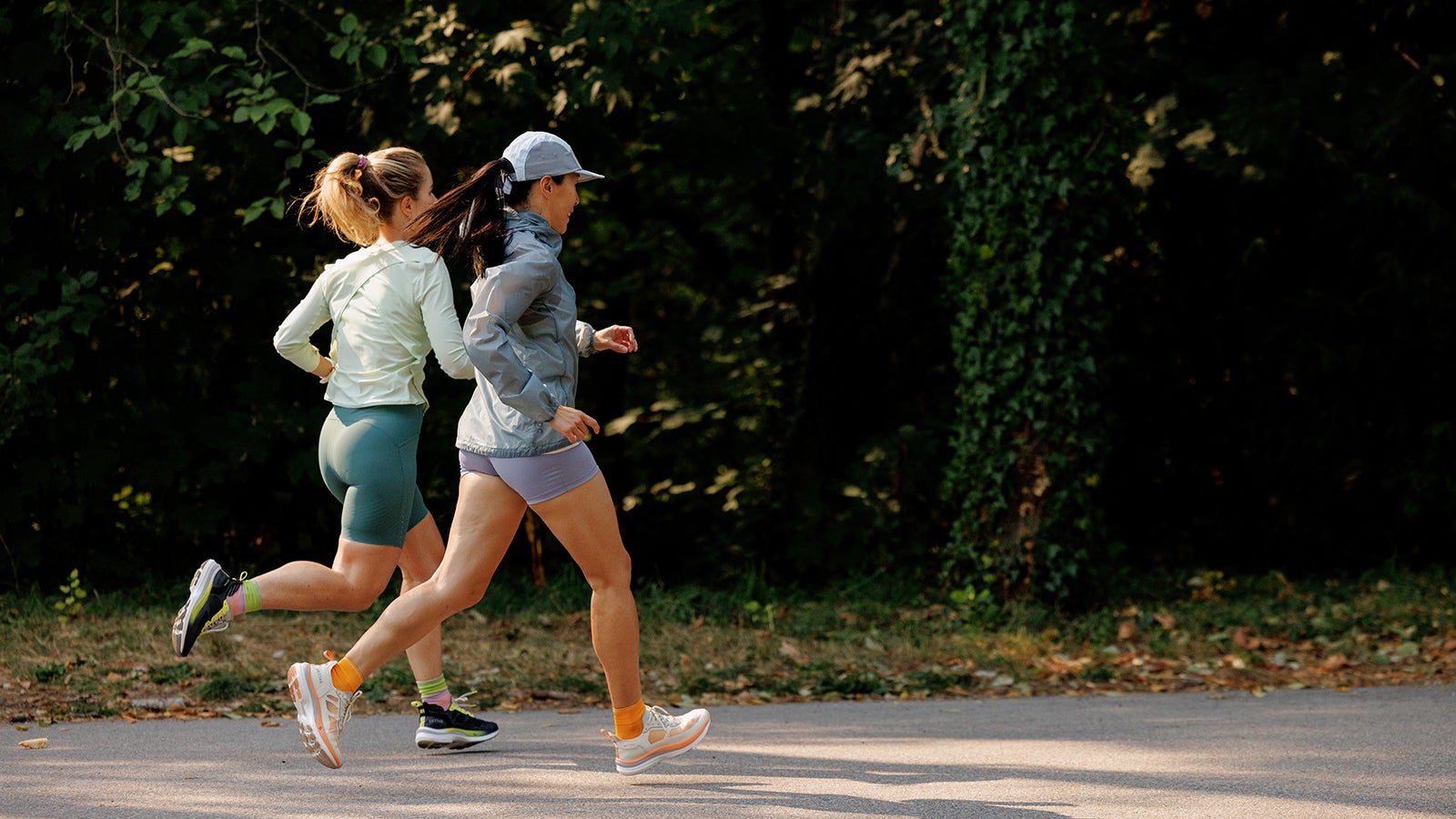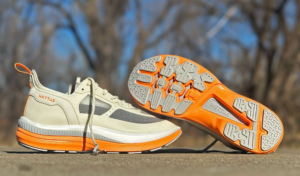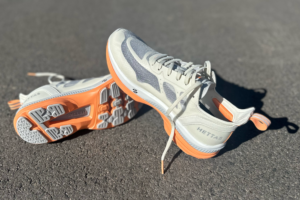Hettas, A New Women’s Running Shoe Brand is Investing in Women’s Running Research

Lindsay and Kyle Housman had dreams of starting a women’s sports brand together someday. Maybe when their twin daughters were out of the house. But all at once, the problems girls and women face in sport compounded in their home, and they knew they couldn’t wait that long.
In 2019, Lindsay started noticing hormonal changes and pain in her feet after exercising. She remembers feeling frustrated at how complicated women’s bodies could be, unable to find relief in any athletic shoe.
It wasn’t long after that, for the first time, their eight-year-old daughters were treated differently than the boys they’d been playing sports with for years. The girls were not recommended to advance in their ski school because of their “petite” size, even though they were excellent skiers.
The similarity between what was happening with her own body and her daughters’ became very clear to Housman. On opposite ends of the age spectrum, they were all subtly being pushed out of sports. Women’s Sports Foundation names social stigma and decreased quality of experience as two of the main reasons why women and girls drop out of sports. The organization also notes that girls quit sports at a disproportionately higher rate than boys and men. By age 14 girls stop participating at twice the rate of boys.
“The tie between women’s bodies and hormones and what goes on as we go from puberty to postmenopausal, as well as how sports influences our mental health and our ability to be high functioning confident adults,” says Lindsay Housman, an idea that kickstarted a conversation between her and her husband Kyle about launching a brand that would also advance women and girls in sport through research.

The Shoes
The goal was to create a product that would allow more women to stay active longer in life. Last November, the Housmans, along with founding product partner Doug Sheridan, a longtime footwear developer who has has held senior management positions and consultancy roles with Adidas, Puma, Converse, Etonic, Brooks, New Balance, Craft and Inov-8, officially launched Hettas, a new women’s only shoe brand.
Hettas’ performance running shoes are available in three variations, one for long runs (Alma Cruise), one for tempo runs (Alma Tempo), and one for speed workouts (Alma Speed). Each was built around a women’s specific foot form (known as a last) and feature a semi-flexible Pebax plate and a highly responsive supercritical foam.
Each model retails for $198 and have identical stack heights 33mm/23mm and similar aesthetics, but are differentiated by weight and foam densities, with the Cruise on the heavier (9.3 ounces), more cushioned side and the Tempo and Speed being lighter (8.2 ounces) and firmer. Furthermore, each pair of shoes comes with two insoles: A thicker, more cushioned and a thinner pair that can provide an additional 1/2 size of space for a runner’s feet to provide a more customizable fit.
Lindsay Housman says their priority of building a shoe for women informed their choice of materials. “We have been playing around with different foam densities, playing around with different types of plates,” she says. “One of our theories was that we could achieve a very responsive, high-energy shoe without using a carbon plate.”
Carbon-plated shoe research has, in the past, only used a male force profile–the force put into the shoe on each step. If women are putting less force into the shoe, the Housmans asked, are they getting the full responsiveness that men are getting with a carbon plate? Could it be better?
In addition to material decisions, design choices for this first iteration of Hettas’ shoes were made keeping anatomical differences between male and female runners in mind. Women have different average height and weight than men. Women’s broader pelvises change the angle between the quads and the knee (called the Q angle), both of which affect how women carry themselves. Female feet also typically have narrower heels, lower ankle heights, and higher arches–accommodations that can be seen in the shoe.
Hettas is one of several companies now designing shoes for those unique aspects of women’s feet with female-specific lasts, including Lululemon, Under Armour, Puma, Altra, and Saysh.
Megan Searfoss, owner of the Ridgefield Running Company in Connecticut, can corroborate those differences in the women she fits into shoes at her store.
“The biggest issue women have with fit is because our heels are narrower, our arches are sometimes a little bit longer and taller,” she says. She also sees a lot of women struggling with bunions, a problem she attributes to a habit of wearing high heels. For that reason, she says, it’s important women’s shoes also have wider toe boxes.
Despite these widely recognized differences, in this era of expanding options, some are questioning the need to label gender so heavily, while others who have struggled to find a running shoe that fits applaud the long-overdue innovation.
Some shoe retailers, in particular, are skeptical about how much of a difference women’s specific shoes can make. For now, Searfoss says they’ve been getting by just fitting women into custom insoles to tailor the fit of their shoes. “Is it better–and more cost-effective–to do that rather than start segmenting shoes and having a brand specific to just women?” she wonders.
“There’s so much variability between genders,” says Brittany Katz, owner of Terra Running Company in Cleveland, Tennessee, “that we fit women in men’s shoes often, especially if they’re larger sizes in women’s shoes, because there are more options if you go to a D width in a men’s last.”
RELATED: Woman-Owned Ridgefield Running Company Named Best Running Store in America
The Research
The Housmans, however, believe there is a true need for a women’s shoe. It’s just that maybe the secret formula has yet to be discovered.
To get there, the Vancouver-based company has partnered with Simon Fraser University on three studies. The first two the Housman’s funded themselves–a focus group survey of recreational and competitive runners to understand what fit and comfort issues women runners were actually having and a literature review to see what research was available on the anatomical, physiological, and biomechanical differences between male and female runners.
Chris Napier, director of SFU’s Run Lab, was surprised by the results of both the literature review and the survey. In the focus group, what was striking was that the runners had collective fit issues, but thought they were the only ones who had them. And because they surveyed a wide age range of women (in their 20s to their 70s), age-related trends also began to come through–things like osteoarthritis and bunions, which women are more likely to have than men.
In the literature study, Napier pointed to the shocking lack of research on female-only groups or research comparing males and females. “So, a lot of the research we look to is based on men,” he says, “assuming that women would respond the same way or present the same sort of characteristics.” But in the studies they found that do compare males and females, Napier says the differences are very clear.
Both those studies guided the initial Hettas product design and the biomechanical study that is currently in progress–looking at how specific shoe features are leveraged to improve running economy through a female-specific biomechanics lens. The team (in partnership with Arc’teryx) was awarded a grant by the National Sciences and Engineering Research Council of Canada.
Napier is interested in figuring out how female biomechanics might change as a result of cyclical changes in the menstrual cycle or through life changes like menopause. All this hopefully leads to an answer about whether or not footwear can be designed to accommodate those changes and prevent injury.
“The problem is, by looking at this stuff, we realize how little has been done, and that we really have to start at the bottom and provide that basic research to inform the next steps,” he says. “There’s just been this assumption that everything is gonna be the same for women, when in fact, not only is it different for women, but it’s different between women and even within the same woman at different times.”
RELATED: How Running Shoes and Coffee Help a Woman-Owned Business Build a Sense of Community

All of this is building a foundation to hopefully push the development of the shoes forward, not just for Hettas, but for everyone. Lindsay Housman says it was important to work with an independent third party on the research and also to have it published when complete. “I’m really big on making sure that whatever we are learning gets out into the world.”
Though Hettas is starting with running shoes, it’s not the end goal. Once they’ve nailed the running shoes (Housman sees it being their main focus for at least five more years), they’ll incorporate other areas where women need good shoes to perform–cross-training, weight-lifting, tennis, walking, and so on.
Searfoss and Katz expressed concern about a startup like Hettas surviving when it’s up against heavy-hitting established brands. But they all hoped they would.
“What I think it does is pushes the industry forward,” Katz says. “If a brand like Hettas pushes some of the big brands to also do some research or use their research to make a women’s-specific shoe … then I think that’s great.”
RELATED: Lululemon is Pushing the Boundaries for Female Athletes by Launching ‘FURTHER’
Malissa Rodenburg is an independent science journalist, focusing on research and discoveries that thread into the context of everyday life. She lives in Seattle, Washington.